Follow Me
Latest Posts
- Cool, Sustainable Packing and Shipping Solutions for Earth Day
- Paper Doll Shares How To Select a Shredder, Shred Responsibly, and Save
- Paper Doll’s Ultimate Guide to Tax-Smart Organizing: 2024
- Paper Doll Explains Aspirational vs. Inspirational Clutter
- Paper Doll Shares 3 Quirky & Cool New Office Supplies
Search Best Results Organizing
Subscribe to the Paper Doll Blog via Email
The Humble Index Card: Organize Your Life, Then Organize Your Cards
Posted on: October 25th, 2021 by Julie Bestry | 22 Comments
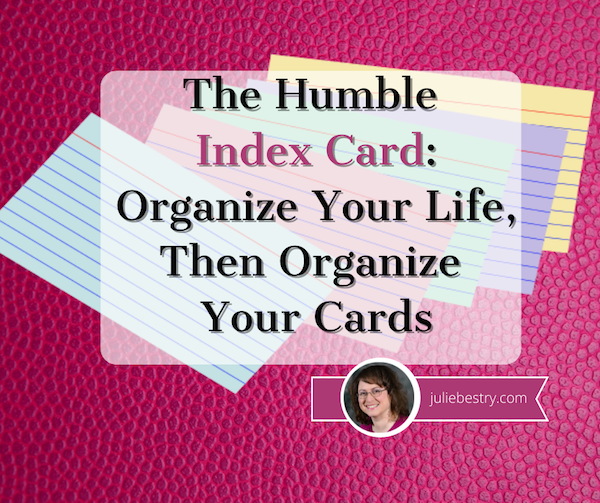
When was the last time you used an index card? Chances are, you don’t give a lot of respect to the humble three-by-five, but we owe so many of our systems, including almost every type of categorization and computerization, to what first got plotted out in a precursor of the little cards we know so well.
Index cards, of a sort, have been around ever since the 1760s, when Swedish botanist Carl Linnaeus, the father of modern taxonomy (the science of classification), figured out that he could name, categorize, and keep track of animals, plants, and minerals. All that Latin nomenclature, with genus and species and sub-species, needed to be written down somewhere, and Linnaeus figured out how to square it all away.
I know, it’s hard to believe someone had to invent an index card, but realize that file folders weren’t even invented until the late 1800s, filing cabinets came to market in 1898, and paper clips showed up around 1900. If you crave more about the history of office supplies — and I mean, who doesn’t? — you might like to check out:
A Place for Everything: The Curious History of Alphabetical Order by Judith Flanders (which is about so much more than just alphabetical order, and provides some eye-opening backward glances into how hard it was to organize information throughout most of recorded history).

The Perfection of the Paper Clip: Curious Tales of Invention, Accidental Genius, and Stationery Obsession by James Ward, which offers intriguing narratives (with a British twist) on how all our office supplies were developed.

In the world of Evernote and OneNote, of CRMs and productivity apps, the humble index card often gets lost in the shuffle (if you’ll pardon the card pun). But there are a variety of ways to organize information and knowledge to help you lead a more orderly life — inexpensively, easily, and without internet access.
I have nothing against using the web and all the magical apps available to help you achieve your goals, but Paper Doll would be doing a disservice not to note the old-school ways you can organize your life with index cards. And of course, while I’m at it, I’ve got a deep dive on options to help you organize those index cards to keep clutter at a bare minimum.
WHAT CAN YOU DO WITH AN INDEX CARD?
Think back. What was your earliest interaction with index cards? Was it Grandma’s recipe for your favorite cookies, perhaps with an oily thumbprint in the upper corner of a card covered with her curling scrawl? Maybe you learned how to do geometry proofs with each card bisected vertically? Or perhaps you studies for the SAT vocabulary section using index cards as flash cards?
In this digital age, you can still do so much with a package of 3″ x 5″ index cards from the dollar store. Off the top of my head, you can use an index card or stack for:
- Address Collections – The problem with a print address book is that once you fill up a “popular” letter (M? S?) until all the blanks are filled, or if one of your vagabond friends has used up an entire page of one letter of addresses for her travels hither and yon, you need to acquire a new address book to make up for the oodles of scribbles and cross-outs. Sure, using the Contacts app in your phone is ideal, unless you’ve somehow failed to back your phone up to the cloud, in which case, one accidental trip through the washing machine can erase a lifetime of contacts. But index cards were a simple, inexpensive precursor to a Rolodex and continue to make an appealing alternative to digital address apps. Using one card per person/family lets you keep track of addresses, phone numbers, email addresses, the names of newly-arrived babies, and so on. When one card has enough cross-outs and re-writes, just replace it with a new index card rather than a whole new address book.
- Customer Relationship Management (CRM) — Yes, a CRM software program is the gold standard for new businesses, and I wouldn’t encourage you to start a business by keeping this kind of information on paper. But if you’re the kind of person who just doesn’t embrace technology for everything, using an index card with your client’s name, phone number, birthday/anniversary, and key preferences might be a good way to help you get started. When your customer reaches out to you, or vice versa, you can put a date on the line, with a quick note about the conversation, letting you trace the history of the relationship over time.
- Expense Logs — In the olden days, we wrote checks and then noted information about the transactions in our check registers. Paper Doll still uses a register for every transaction, but is prompted by receipts (from debit card transactions, mostly) to remind myself what to log. However, just carrying an index card in your wallet gives you an easy way to keep track of your financial activities in the moment. Write the date, the amount, and a one-line description of what you bought. If you tend to use cash, this will help you track your expenses without need of logging into your bank account; if you use your debit or credit card, mostly, this offers assistance for keeping tabs on your day-to-day spending (as using plastic doesn’t “feel” like money, and you may not realize how much outlay is going on).
- Meals and Snack Logs — Are you on any kind of eating plan? (The word “diet” is so last century!) Whether you’re keeping track of protein grams and carbs for nutritional reasons, calories for health, or exact foods to figure out a mystery allergy, index cards offer a quick solution.
- To-Do Lists — Start your day with your three most important goals on an index card. When you have only three inches by five inches of real estate, you’re going to be pithy and get to the point. (Sure, you can use a Post-it® Note, but lined index cards give you a little more formality.) I like to pick 1 big task, two medium-sized tasks, and three small tasks, but even these should fit on a “today” card.
- Wanna-Do Lists — Yes, if your friend recommends a book, movie, restaurant, or podcast, you can pull it up in your phone, but only if your phone is handy. (And then, how much more likely are you to then be distracted by your phone and ignore your friend?) Keeping a running list on a card or two in your wallet or purse lets you pull it out when the context is right — when you’re trying to find somewhere to eat on Saturday night or roaming the bookstore (or even surfing online) to find something to read.
- Flash Cards — I love my Duolingo for learning Italian, but to remember attraversiamo, già, and sempre, or to distinguish among ora vs. poi vs. allora, you can’t beat a flash card. Whether you’re learning bones and ligaments in medical school, national capitals and top exports in geography, or embracing those definitions for the SAT verbals, flash cards are inexpensive and easy to make, quick to shuffle, and require no battery charge. Plus, research shows that we remember what we hand-write, with greater context and nuance, than what we type.
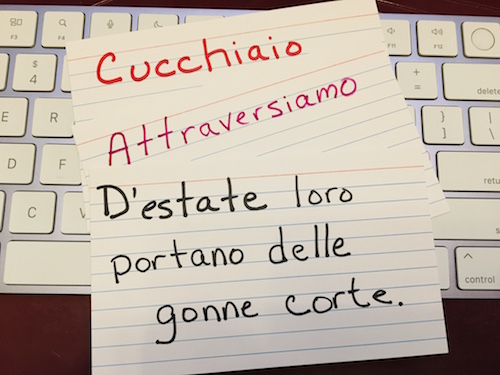
- Recipes — This one can’t surprise you. For a century, families have passed down handwritten recipes on index cards.
- Household Inventories — Sure, you’ll create the best, most complete inventory if you video your possessions and log them in software like HomeZada or Sortly, or even in a self-created database in Airtable, but if you want to do a quick-and-dirty inventory of your space, noting descriptions, model numbers, serial numbers, etc., an index card inventory is a great start.
- Research — Whether you’re writing a report for Social Studies or looking up some genealogical records, index cards provide a way of encapsulating information. You can use numbers and letters to code which things are related to what. My 7th grade English teacher taught us to create an outline (with Roman numerals and letters, breaking down each section), putting each bibliographic item on its own card with its own code, and then each fact or quote got a card, linking it to the outline and to the bibliographic source. Not only did I use this method (with small modifications) in college and graduate school, but I incorporated into research I’ve done for my ebooks and other publications. The size of the index card forces you to focus on bite-sized pieces of information.
- Maps for Creative Endeavors and Adventures — Writing a novel? Use index cards to keep track of the essential traits of each character, and then map out your plot points, and put it all up on a bulletin board. (This method is actually the model for the popular Scrivener software.) Planning a vacation and can’t decide among all the options? Make a card for each alternative, with essential information like dates and times each museum or attraction is open, then sort by location (Paris, London, Madrid? Niagara Falls, Buffalo, Rochester?) and order by priorities. Bring the stack with you on your trip, and if weather or a venue closure blocks your plans, you’ll be able to pick the next priority in the stack!
SPECIAL USE OF INDEX CARDS: THE HIPSTER PDA
Have you ever heard of the Hipster PDA?
Back in 2004, Merlin Mann, writer and founder of the productivity website 43 Folders, (somewhat) jokingly turned his back on the increasing complexity of what we used to call personal digital assistants (like those pre-iPhone Blackberry and PalmPilot devices). He put forth the idea of using a small stack of index cards and a binder clip to gather essential information and keep it at hand.
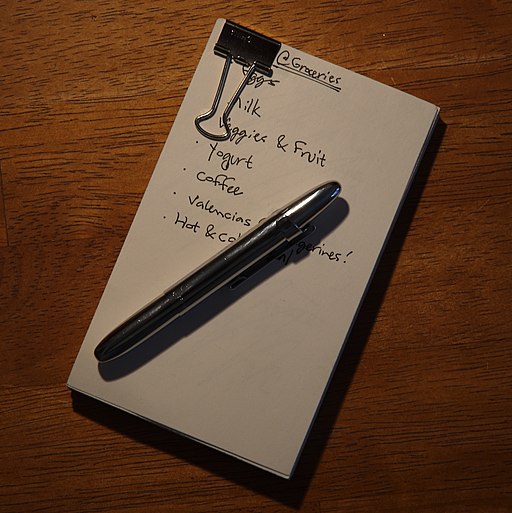
Teo, CC BY-SA 2.0, via Wikimedia Commons
While Mann may have been applying the concept with a bit of tongue-in-cheek goofiness, the followers of David Allen’s Getting Things Done: The Art of Stress-Free Productivity (GTD) approach picked up the idea of the Hipster PDA and ran with it. In GTD, one of the focuses is on keeping context lists, so that when you’re at the office, you have an Office list; when you’re at the supermarket, you have a Piggly Wiggly list, and so on.

While most people are keeping that kind of list in the reminders app of their phone, fans of the Hipster PDA have a context card for each item or task to be slotted where appropriate.
The Hipster PDA requires only index cards (used vertically or horizontally, as you prefer) and binder clips. If you want, you can use multi-color card packs to color-code different features or contexts. There are even crowdsourced templates all over the web (here’s a set at DIY Planner) and on Pinterest to help you use index cards to create the productivity approach of your dreams.
HOW CAN YOU KEEP YOUR INDEX CARDS ORGANIZED?
The answer may seem almost ridiculous. After all, a simple rubber band around a packet of index cards should be enough to keep them from spreading out across a desk drawer, a high school locker, or an office. But if you’ve ever come across an old stack of index cards, wrapped in a rubber band like that, you know that rubber bands dry out and break. That’s why the Hipster PDA uses binder clips.
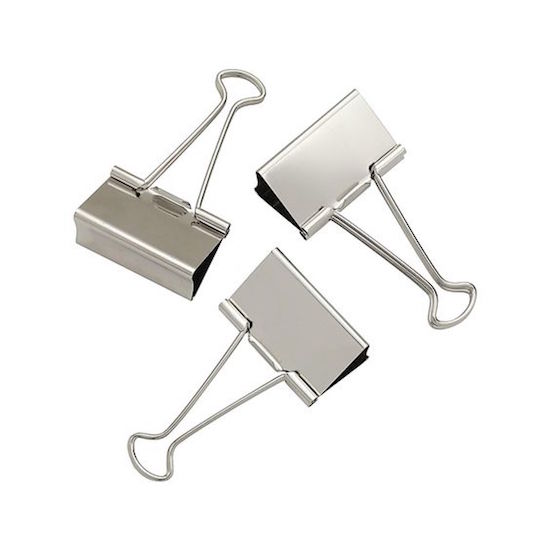
For many, the main drawback to using index cards is the potential for disorganization or card clutter. However, there are a variety of solutions you can use, whether you want your card stack to be mobile or just neatly arranged on your desk our counter. I’ve gathered alternatives for corralling 3″ x 5″ cards, as they are the most standard, but you should be able to find similar solutions for 4″ x 6″ and sometimes even 5″ x 8″ index card storage.
Note card rings — Don’t be tempted to think you can organize your cards with traditional keyrings, the kind where you have to pry the metal apart with your fingernails or a key. Use a search term like bookbinder rings or loose leaf binder rings. You want the kind that lets you push inward from both sides and then pull the sides apart to grant you access. Depending on the thickness of your card stacks, you might want to get an assortment of sizes. A few dozen rings (which you can always use for other purposes) won’t run you much more than $5 or so.
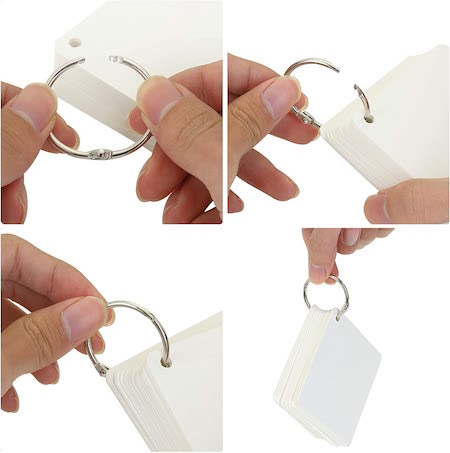
Index card binders — If you want your cards to have a little more protection, you can opt for a miniature binder, similar to the kinds of three-ring binders you’d use for loose-leaf paper. This Oxford Index Card Binder has a poly cover, two rings, and two poly dividers. It’s available in red, blue, or green for about $13.
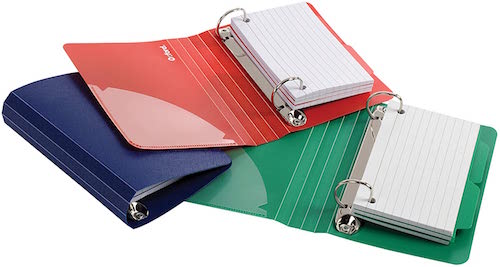
Index Card Cases/Boxes — If you have small stacks of index cards you want to keep attractively but make portable, another option would be a poly index card case or box. I really like these colorful ones from DocIt. Each poly case (available in blue, pink, grey, or green) has a snap closure, holds 100 cards, and includes five dividers with adhesive label tabs. You can buy one for about $5, or packs of four ($12.99) or 24 ($35.99).
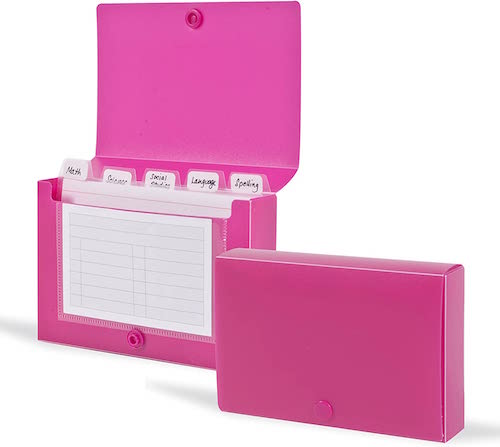
If you want a greater variety of colors for a similar price, check out these four-packs from Emraw. Note that these aren’t accordion-style; I find that accordion-style index card cases hold fewer cards, and chances are you won’t need the kind of mini-sections they enable.
Plastic Index Card File Box — This is probably what you used in school, and it’s a stalwart of the office supply arena. Plastic is water-resistant, durable, inexpensive, and won’t rust, and these kinds of card file boxes usually fit easily in a drawer or on your desktop, but are light enough (with secure enough closures) that you can pop them in your backpack. But, of course, it’s plastic, and not everyone likes petrochemical products. (Plastic = petroleum = dead dinosaurs.) You can buy a brand name version at any big-box store, or get one at your nearest dollar store for no more than $3-4 each, or try this Alfion set of four for about $16.99 from Amazon.

Metal Index Card File Boxes — I grew up with Paper Mommy‘s gravy-brown metal index card file box housing one set of her recipes. The metal version isn’t as lightweight as the plastic ones, and they usually lack a secure closure, making them poor options for mobile card storage. They also tend not to be very pretty. However, with a little creativity (and some paint, washi tape, or contact paper) you can make your card box match your personal style.
You used to be able to find metal card file boxes in the same size/shape as the plastic file boxes above, but in recent years, larger/deeper metal cases have become more popular. This Steelmaster card file box has a 900 card capacity and is 8 1/2″ deep; it costs $26.60 at Amazon.
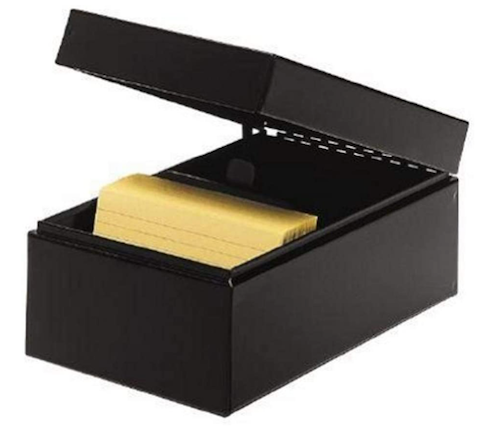
Collapsible Card File Boxes — If your need for card file storage ebbs and flows, you might want to consider a collapsible index card file box. This one from Snap-N-Store holds 1100 3″ x 5″ index cards. The box is made of sturdy fiberboard with a water-resistant laminate cover, metal snaps and steel-reinforced corners. It runs $10 at Amazon.
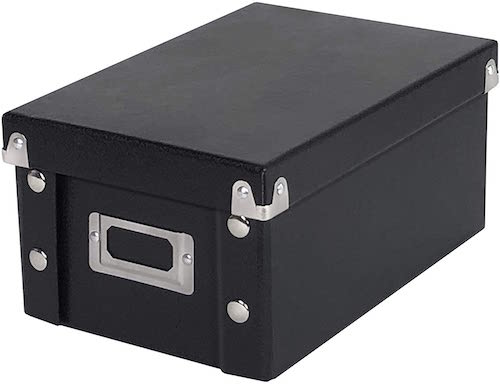
Decorative Solutions — While the above solutions are standard, you should be able to find a wide variety of “fun” options for organizing your index cards if you search beyond office supply stores.
If you want an old-fashioned wooden file box, perhaps as a gift box already filled with recipe cards, your best bet is to haunt Etsy or specialty craft shops; the search terms “wooden recipe box” should pull up something useful. I found this ArtMinds® wooden recipe box for $6 at Michael’s.
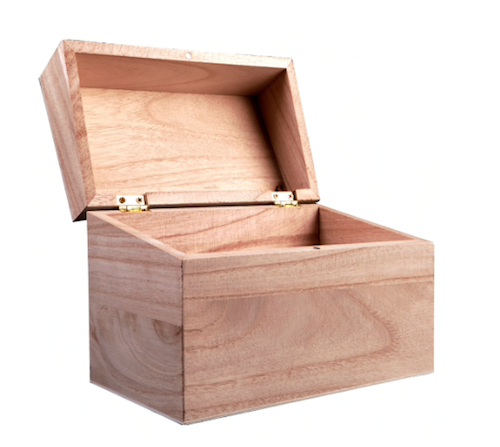
I have to say, however, that my favorite index card storage option, from an aesthetic perspective, is the Oxford at Hand Note Card Organizer. Each metal organizer has a non-skid base to keep it in place and prevent it from squeaking against your desktop or countertop. It’s designed to hold 3″ x 5″ cards and comes with 25 matching dot-grid cards, but of course you can use any card style.
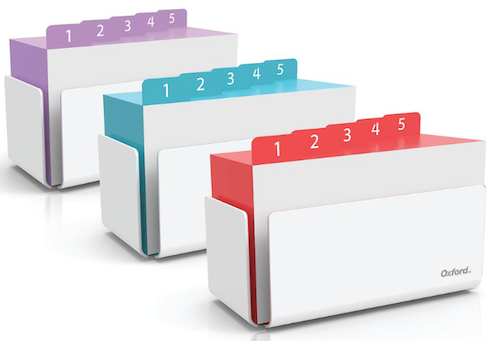
The Oxford at Hand Note Card Organizer comes in Charcoal Grey as well as three designer colors: Coral, Shoreline Blue, and Orchid Bouquet. They run $22.75/each, but must (unfortunately) be ordered in sets of 6 or 12 if you buy directly from Tops Products (Oxford’s parent company). However, you can get a single case in the Charcoal Grey and Shoreline Blue versions on Amazon for $12.99/each. (I’m still searching for a vendor selling just one in Orchid Bouquet, so please write in if you see them anywhere!)
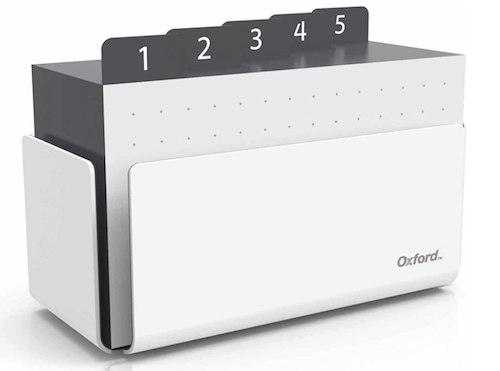
Of course, there’s so much more to be said about index cards (sizes, styles, patterns), storage, display options, and uses, but we’ll have to save that for another time. Do you have a strategy for using index cards that I didn’t mention? A favorite storage solution for cards that I didn’t include? Please share in the comments below!
Disclosure: Some of the links above are affiliate links, and I may get a small remuneration (at no additional cost to you) if you make a purchase after clicking through to the resulting pages. The opinions, as always, are my own. (Seriously, who else would claim them?) For more information regarding how Best Results Organizing handles affiliate links, please see the affiliate section of the site’s Privacy Policy.




I’m laughing as I read this because my youngest was a HUGE fan of index cards. As in, she used to ask for them for Christmas. I honestly think we had almost all of those storage devices for her various cards. I gotta say, they worked for her. She was an excellent student and was very organized.
Never underestimate the power of paper. Great inventions stick around for a reason, right? I always have index cards on hand, both small and large!
How cool, Seana! Your daughter and I would have a lot in common, I’m sure!
Back when I was in college and grad school, my only choices were the plastic boxes and the metal ones; I’d have loved the snap-closure cases. And if I find the Oxford at Hand in Orchid Bouquet, you KNOW I’m going to snap it up!
I love index cards. Thanks for the history. I think this has become extinct for me because I moved on to sticky notes. I would use them for foreign languages in college. I even started organizing topics with index cards for my organizing newsletter when I started my business in the 90s. I even helped clients sort their chapter topics to find the right order for their book. There is also something to be said about the tactile that happens when writing on index cards. It helps stimulate creativity and helps determine a process too.
You’re so right, Sabrina. That tactile experience makes magic! The same thing that makes a printed book feel more “real” to me than a Kindle title (and makes me more inspired to read it) is at play when it comes to reading and studying via index cards. I’m a fan of sticky notes for some tasks, but for flash cards (flipping front to back) nothing beats an index card, and I’ve been known to fill in cards with tasks and use my entire floor as a giant spreadsheet with each card serving as a cell.
As usual, you’ve outdone yourself. I mean, who else could write such an interesting, engaging post about our old friends, the valued index card? YOU!!! Only you!
Thank you for the index card and office supply history lesson. While I love all things office supply-related, I never thought about where they came from or when. Now I know. Awesome!
Full disclosure here. I STILL use index cards. I love them. They are right-sized and a good weight. These days, I use them mostly for writing a grab-and-go list for when I’m running errands. And I still have a box of recipes on index cards. My original client tracking system was on index cards. And in fact, when my husband designed my office, he created two separate custom drawers to house them. They’re still here, but I rarely look at them anymore. But they worked for many years. I even used them to write out the driving directions to my clients’ homes. I could hold the steering wheel and index card at the same time. But now, with Google maps, the direction cards are obsolete.
Lastly, while I don’t have a use for them, I LOVE those Oxford Hand Note Organizers! Tempting.
LOL, Linda, I think you mean, “Who else would even try to write about index cards?” I definitely blog to the beat of a different drummer. 😉
It sounds like you have your own rich, robust index card history. I bet those customer drawers are divine! And yes, the Oxford at Hand Note Organizers are nifty. Stylish simplicity!
Julie, every time I see a new post of yours come up I know it’s time to get a drink and a snack and learn about things I didn’t know I wanted to learn about!
As usual this post is thorough, engaging, and full of helpful product recommendations. I can’t think of anything else to do with an index card, except maybe use it as a bookmark!
You’re making me blush! Thank you for the lovely compliments. And yes, a bookmark! But I have just enough other information about different kinds of index cards to make another post. Maybe my end-of-year revisit post? Thanks for reading!
Index cards! Traditional but still in style. My mom still uses index cards for all types of lists, etc. At 89 she’s not going to change and why should she. It works for her.
I liked seeing all the products you suggested to work with the cards too.
Go, Janet’s mom! Whoohoo!
Thanks for reading the post.
Julie, I love this! I use index cards for many things. I still use an address book (made by Levenger) that has small cards you pop into place. So when someone’s address changes, no need to cross it out. Just replace the card! Very handy and a great back up for all those addresses in our phones. Levenger also used to make (don’t know if they still do) a stadium sorter for index cards so you can prioritize those to-dos or organize research. There are endless ways to use this simple invention. Thank you for such a wonderful post on this useful organizing tool.
Shhhh, the Levenger “bleachers” are a secret for a future post. 😉
I used to use index cards all the time but now I mostly use them with clients to help them break down and organize a large project. Each task is written on a card as we brainstorm. Then they are put in a logical order. Then dates to do the tasks are written on the cards.
I think that’s a great approach, Jonda! I’ve been known to do the same and then use my floor as a makeshift spreadsheet, with each card serving as a “cell” with columns grouping similar card types.
I’m a huge fan of index cards. Mine are unlined, 17 point card stock and I order them in bulk.
I use them for my daily task card, which is a short to-do list of my top priorities for the day, including what Mark Forster, my planning guru (author of Do It Tomorrow) calls my current initative.
He’s British, I was born and raised there, and it tickles me to hear myself saying in my most English accent, ah yes, my current in-IT-i-a-tive!
Because the card is thick, it’s easy to find in my purse and carry around with me during the day. When the day is done, I use the other side for the next day and then recycle. I suppose I could save them for posterity but their real function for me is in the moment.
I’ve got some of Forster’s books! And I love that you’re an index card girl. Thanks for reading and sharing your thoughts, Lucy! (And hopefully, someday, we’ll get to meet up in person so I can soak up some of your divine accent!)
I used index cards extensively in the past, for both personal and business purposes. When I started my business, I created an index card for each client and kept track of the work I did, the time it took, and the dates. I stopped doing that a long time ago but it was definitely an easy-to-use system.
I love that a small piece of paper can have so much power! Thanks for reading!
Back when we gathered with friends to watch the Super Bowl in the winter, my husband would make Super Bowl Bingo cards out of index cards. It was also a great way to declutter, as we would give out unwanted gifts from Christmas away as prizes. 🙂
Oooh, that’s a two-for-one reply! Brilliant ideas, Phaedra!
This is a really great article, well done! To help your readers they might like to know about our digital index cards app – NoteDex (https://www.notedexapp.com). It’s a true index card app where you can create life like index cards – with text, images and even handwriting! You can even organize them into folders and add tags just like the real thing. Keep up the good work. We all love index cards! Prem (Founder and CEO, NoteDex)
Thanks for reading, Prem, and I’ll be sure to check out the app and consider writing about it for the Paper Doll blog!